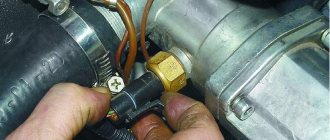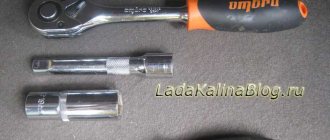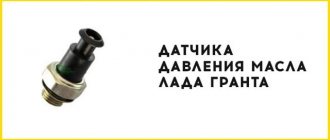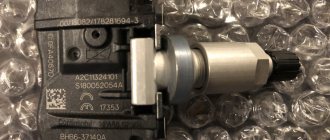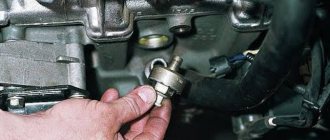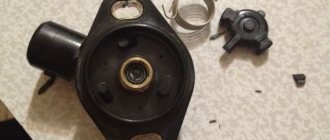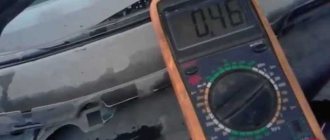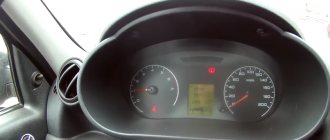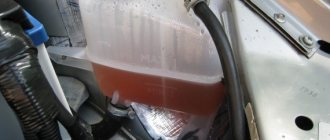I think that many Kalina owners already know that under the hood of the car there are two coolant temperature sensors. One of them is installed on the side of the cylinder head, which sends a signal to the arrow in the instrument panel. And the second is located on the thermostat, and it transmits its readings directly to the ECU to turn on the fan. In this article I will talk about the second engine temperature sensor (coolant).
So, to replace it on Kalina, you will need the following tool:
- Phillips screwdriver
- Driver or ratchet
- Head 19 - best deep
- Extension
Progress of repairs to remove and install the sensor
To make dismantling more convenient, you need to unscrew the clamp of the intake pipe, which goes from the air filter to the throttle assembly:
And after that you need to pull the pipe, pulling it out of its seat. And then move it a little to the side so that it does not interfere, approximately as shown in the photo below:
And the photo below clearly shows the location of the temperature indicator sensor:
First you need to disconnect the power plug, which is fixed in the same way as most others - just lift the latch up and pull the plug:
Now, using an extension cord and a deep socket, unscrew the sensor. If the pipe still gets in the way, you can move it a little more to the side with one hand, and at the same time put on the head with the other. Then unscrew the sensor with a ratchet:
After this, you can completely unscrew the sensor by hand. And this is what it looks like after extraction:
Now you can start replacing this part. Its price is approximately 150 rubles. So, even if you have to change this part, this repair will cost very little.
The cooling system is responsible for the optimal temperature regime of the power plant, at which the power output is maximum. This system includes a radiator cooling jacket and pipes through which fluid circulates. Circulation is provided by a pump driven by the crankshaft.
The system also includes a thermostat, which ensures quick warm-up of the engine by shutting off the pipeline going to the radiator, while the liquid circulates only inside the cooling jacket. When a certain temperature is reached, the thermostat opens the pipe, after which the liquid circulates in a large circle, including the radiator.
The radiator cools the heated liquid. To cool the liquid faster, a fan is installed on the radiator, which creates additional air flow. But this fan does not always work; it turns on only when the liquid temperature exceeds a certain value.
Coolant temperature sensor
To monitor the coolant temperature, a coolant temperature sensor is included in this system. The readings of this sensor are displayed on the dashboard, which provides the driver with information about the temperature conditions of the engine.
But this is not the main task of this sensor. The coolant temperature sensor transmits temperature data to the electronic control unit, after which this unit adjusts the fuel supply depending on the temperature. When the engine is cold, based on the readings of this sensor, the control unit sets an enriched mixture; after warming up, the fuel mixture becomes normal. Based on the readings of this element, the electronic unit regulates the ignition timing.
Operating principle of the coolant temperature sensor
The device that measures the temperature of antifreeze is a negative temperature coefficient mechanism.
What does it mean?
The operation of the thermistor is based on the conversion of thermal data into resistance numbers, which are smaller the stronger the heating of the antifreeze.
Knowing these principles, you can check the performance of the device yourself, having at hand only a thermometer with a sufficiently wide measurement scale and a universal measuring device (multimeter).
Signs of a DTOZ malfunction are easy to recognize, but it is worth knowing that they do not always indicate a breakdown of this particular sensor. These failures may indicate a breakdown of the engine ventilation system, damaged wiring, or damaged contacts.
Temperature sensor Lada Kalina
If the Kalina coolant temperature sensor fails, the following processes can be observed:
- exhaust gases have an uncharacteristic color and composition, polluting the environment;
- fuel consumption increases sharply due to the fact that incorrect detector data forces the system to enrich the air-fuel mixture more even when this is absolutely not required;
- consumption and coolant increase, since under conditions of constant overheating of the engine it is produced ahead of time or simply boils away;
- malfunctions in the engine, which manifest themselves in the following moments - it is difficult to start, difficult to stop, it periodically stalls, and also idles very poorly;
- the fans cooling the motor are constantly running (or, on the contrary, they are not working, which is much worse, since this can lead to the motor boiling and its complete failure);
- blinking of the detector on the dashboard, as well as a message on the on-board computer screen with the corresponding error code.
Design, principle of operation
The design of this sensor includes a thermistor - a resistor that changes resistance depending on the temperature surrounding it. This thermistor is placed in a metal case with a thread applied to it. A tail section made of plastic is connected to this body. This part contains contacts for connecting wiring. One contact is positive and it comes from the electronic unit, the second is negative and it is connected to ground.
In order for the thermistor to work, a voltage of 5 V is constantly applied to it. This voltage is supplied to it by the electronic unit through a resistor having a constant resistance. Since the coolant temperature sensor thermistor has a negative temperature coefficient, as the temperature increases, its resistance will decrease, and the voltage supplied to it will also decrease. Based on the drop in this voltage, the electronic unit calculates the engine temperature and also displays its value on the dashboard.
The exact installation location of this temperature sensor differs from car to car, but only slightly. It can be installed in the cylinder head near the thermostat housing, or on the thermostat housing itself. It must be located near the outlet pipe through which the liquid flows into the radiator. It is located near this pipe in order to transmit accurate temperature data.
Signs of sensor malfunction
This sensor is considered to be very reliable due to its comparative simplicity of design. However, there may be problems with it too. Usually they come down to a violation of the calibration, which leads to a violation of the resistance and, as a result, incorrect operation of the electronic unit, since it performs part of its functions based on the engine temperature.
One of the most obvious signs of failure of this sensor is the failure of the fan to turn on when the temperature exceeds the set value. But this indicator will not be reliable if there are two sensors - the main one, for transmitting the temperature value to the electronic unit, and the additional one, responsible for turning on the fan. In this case, failure to turn on the fan will indicate damage, oxidation of the wiring, or failure of the sensor responsible for its operation.
On modern cars, a malfunction indicating incorrect operation of the coolant temperature sensor is displayed on the display of the on-board computer. However, a fault message does not always indicate sensor failure. Often problems in its operation are associated with broken wiring or oxidation of contacts.
Incorrect functioning of the coolant temperature sensor or a break in its wiring leads to excessive fuel consumption, high idle speed, and detonation. It is possible that the power unit will have difficulty starting after warming up. The biggest trouble that can occur due to the inoperability of this sensor is overheating of the power plant, which can cause the cylinder head to move.
How to understand that the DTOZH is faulty?
Let's look at the signs of a faulty coolant temperature sensor. For the most part, these are reliable devices that rarely fail. The design of the element is extremely simple, but sometimes the element starts to malfunction. Most often, sensor malfunctions are associated with a violation of its readings. The very first sign is a fan that does not turn on. But the ventilator is not the fundamental symptom. Failure of the DTOZ will be indicated by increased fuel consumption, increased idle speed, detonation sounds when the engine is running, poor hot starting and overheating.
You should be careful with overheating - it can lead to dire consequences. Older car models have a dial controller. When the arrow goes beyond the danger zone, the car needs to be stopped and the cause of overheating must be looked for. This may be a faulty injector coolant temperature sensor. In more modern cars, the on-board computer will report overheating. The corresponding diagnostic message will appear.
Sensor check
Checking the functionality of this sensor is not difficult. But before you do it, it is advisable to check the integrity of the wiring going to it. You can also check the voltage coming from the control unit. To do this, you need to disconnect the chip with wires from the sensor and connect it to a voltmeter. After this, start the engine and measure the voltage supplied to the sensor; it should correspond to 5 V. If the voltage is normal, check the sensor for resistance.
Replacing the coolant temperature sensor
The coolant temperature sensor cannot be repaired, so if it is found to be operating incorrectly, it is simply replaced.
Video: Replacing the coolant temperature sensor (DTOZH) VAZ 2115 (2113, 2114)
After purchasing a new sensor, it is advisable to immediately check it using the specified methods. If all readings are normal, it is installed in place of the one removed. Before screwing it into the seat, the threads are treated with sealant.
After installing the new element, a leash is connected to it; it is impossible to confuse the position of the chip, since it has special guide grooves. Next, the coolant in the system is brought to normal. Then you should check whether liquid is leaking through the sensor, and then start the engine.
If replacing the sensor does not give any result, the engine continues, for example, to overheat or does not reach the proper temperature, look for the cause in other elements of the system. It is possible that the thermostat does not work and the liquid is constantly circulating either in a small or large circle.
Share with your friends:
The Lada Kalina family car is equipped with over ten digital sensors that monitor the operation of mechanisms and assemblies. Most often, drivers complain about premature wear of the coolant temperature sensor (hereinafter referred to as DTOZH).
They say it displays incorrect data, and sometimes is completely inactive. The process of replacing the DTOZ yourself is not at all complicated. The task can be done by a driver without experience in servicing equipment.
ATTENTION! A completely simple way to reduce fuel consumption has been found! Don't believe me? An auto mechanic with 15 years of experience also didn’t believe it until he tried it. And now he saves 35,000 rubles a year on gasoline! Read more"
Signs of a malfunction of the coolant temperature sensor (DTOZH)
Not a single control unit (ECU) of a modern car, including the LADA Kalina, can do without the device we are considering - a coolant temperature sensor. In the cooling circuit of the second generation Lada Kalina model, it is located directly on the thermostat housing. The component is connected to the electronic control module via the on-board electrical network. The controller itself receives power from the main voltage source.
Read more: Diesel fuel expiration date - Car service
The controller continuously monitors the temperature parameter inside the circuit. The process is accompanied by a change in voltage. When the LADA Kalina engine is cold, it is high, and as the unit warms up, the voltage decreases. The temperature of the power plant can have a direct impact on a considerable list of sensors equipped with the on-board monitoring and control system.
With the correct ignition angle, the Lada Kalina engine produces its declared characteristics and consumes a minimum of fuel. Enrichment with fuel is required during a cold start of the LADA Kalina engine. The ECU “understands” this state of the engine and issues a command through a corresponding impulse to the injectors to inject a certain proportion of gasoline. After warming up, the volume of injected fuel is reduced to the required level.
Regarding the operation of the sensor in the designated so-called circuits, we note that if it breaks down, then the lambda probe in the Lada Kalina car “sends” impulses to the ECU. In this case, no feedback is observed. As a result, there is a deterioration in the stability of the idle mode.
Every modern car has a coolant temperature sensor. It plays an important role in the functioning of many systems.
In Kalina 2, this element is located in the thermostat housing. It was as if it had been screwed into it and then connected to the controller input. It, in turn, is connected to the main voltage source via a resistor. A low temperature indicator provokes a high resistance, an increased value - a decreased one. This is the principle of operation of the device.
The controller monitors the temperature of the coolant. This process is completely voltage dependent. When the engine is cold it is high, but when the engine is warm, on the contrary, it is low. The engine temperature affects many characteristics, the performance of which is controlled by the controller.
Thanks to this element, the control system performs the following functions:
- sets the ignition (its advance or retard);
- enriches with gasoline;
- captures changes in closed and open loop conditions.
The coolant temperature sensor monitors the volume of exhaust gases. Correct setting of the ignition angle guarantees its low amount. In this case, the operation of the motor is considered more rational.
Gasoline enrichment. At low temperatures, a pulse is instantly sent to the injectors, thereby eliminating fluctuations during engine overheating. This process ensures optimal engine operation at idle.
Changes and control under closed and open loop conditions. If the indicator breaks, pulses will come from the oxygen sensor, but they will not receive feedback. This will lead to poor idle performance. The operation of many vehicle systems is disrupted.
The coolant temperature sensor (CTS) is one of the elements of the engine management system. Its purpose is to control the temperature of the fluid in the cooling system. Based on these data, the engine control unit adjusts the composition of the fuel-air mixture, crankshaft speed, and ignition timing.
On all modern LADA cars (XRAY, Vesta, Largus, Granta, Kalina, Priora or Niva 4x4), replacing and checking the coolant temperature sensor is carried out in the same way.
The coolant temperature sensor (CTS) is not as simple as it might seem at first glance. Many people think that it is only responsible for turning the cooling fan on/off and displaying the coolant temperature on the dashboard. Therefore, if the engine malfunctions, they do not pay special attention to it. That is why I decided to write this article and talk about all the signs of a faulty DTOZH.
But first, a little explanation. There are two coolant temperature sensors (in some cases 3) - one gives a signal to the arrow on the dashboard, the second (2-pin) to the controller. Further we will talk only about the second sensor, which transmits information to the ECU.
And so, the first sign is poor engine starting when cold. How this happens is that the engine starts and immediately stalls. More or less works only with gas. After warming up this problem goes away.
Why might this happen? The coolant temperature sensor may provide incorrect readings to the controller. For example, that the engine is already warmed up (temperature 90 degrees). As you know, starting a cold engine requires more fuel than starting a hot one.
And since the ECU “thinks” that the engine is hot, it gives it little fuel. This is what causes poor cold starting.
The second sign is poor engine starting when hot. Here everything is exactly the opposite. DTOZH may always submit underestimated readings, i.e. “tell” the controller that the engine is cold.
This is normal for a cold start, but bad for a hot start. A hot engine will simply fill with gasoline. Here, by the way, error P0172 may appear - rich mixture.
Check the spark plugs - they should be blackened.
The third sign is increased fuel consumption. This is a consequence that follows from the 2nd sign. If the engine is filled with gasoline, then consumption will naturally increase.
if the actual coolant temperature has increased by 1 degree, the sensor may “say” that it has increased by 4 degrees or may not react at all.
So, if the temperature at which the fan turns on is 101 degrees, and the actual coolant temperature is 97 degrees (working), then, having jumped by 4 degrees, the sensor will “tell” the ECU that the temperature is already 101 degrees and it’s time to turn on the fan.
It’s worse if the opposite happens - the sensor can sometimes underestimate readings. The coolant temperature may already reach boiling point, and the sensor will “say” that the temperature is normal (for example, 95 degrees) and therefore the ECU will not turn on the fan. Thus, the fan may turn on when the engine is already boiling or may not turn on at all.
I will not show tables with sensor resistance values at a certain temperature, since I think this method of checking is not entirely accurate.
The simplest and fastest way to check the DTOZH is to simply remove the chip from it. The engine will go into emergency mode, the fan will turn on, and the fuel mixture will be prepared based on the readings of other sensors.
Read more: What is the optimal engine operating temperature?
If at the same time the engine begins to work better, then the sensor definitely needs to be changed.
For the next check of the coolant temperature sensor, you will need diagnostic equipment. First, you need to check the temperature readings on a cold engine (for example, in the morning). The readings must correspond to the ambient temperature.
A slight error of 3-4 degrees is allowed. And after starting the engine, the temperature should rise smoothly, without jumping between readings. Those.
if the temperature was 33 degrees, and then suddenly became 35 or 36 degrees, this indicates a sensor malfunction.
DTOZH or a sensor that measures the temperature of the cooling system fluid is a mandatory part in the engine control system. Based on the data received from it, the composition of the fuel-air environment is automatically adjusted, as well as the crankshaft speed and ignition timing.
Kalina coolant temperature sensor is an ordinary thermostat. It acts as a resistor, the resistance of which varies depending on the temperature. In short, this element is called dtozh. It is based on a negative temperature coefficient thermistor. Its resistance is directly dependent on temperature.
general information
Welcome! Coolant temperature sensors - if we talk specifically about the Lada Kalina car, then there are only two sensor data in it, one goes to the controller (This is the brain, to put it simply), and the other to the device, that is, one sensor shows what the temperature of the coolant is in car and displays all this on the device, and another one (Which gives readings to the controller) turns on the cooling system fan when the car is boiling, and also regulates the fuel-air mixture (Simply put, when the car is cold, thanks to this sensor it will warm up faster, because the sensor richens the mixture and the temperature immediately rises), both sensor data are important and if they fail they will cause a lot of trouble, especially for the sensor that gives readings to the device, if it stops working, then you simply will not know the temperature of the coolant and therefore the engine can overheat.
Note! To replace both sensors (you will most likely replace only one), stock up on: Wrenches, as well as sockets and a wrench for them, you will also need a multi-meter (This is if you have an old sensor for operability want to check) and a screwdriver!
general information
What temperature sensors are installed
The principle of operation of the DTOZH is as follows: after receiving data on the current antifreeze temperature, the measuring device sends the readings to the electronic control unit of the ECU.
The on-board computer compares the received data with the programmed ones. In case of discrepancy, an error is indicated on the dashboard. The owner of the car, seeing a system error, decides on the nature of the breakdown and visits a service station to order a comprehensive diagnosis.
In addition to the DTOZH, the Lada Kalina car is equipped with an external temperature sensor (hereinafter referred to as the DNT). However, not on all trim levels, but only on Lux and Premium.
If desired, the owner can install the measuring equipment himself. The installation work is not at all difficult. In time no more than an hour.
DTOZH is designed to monitor the temperature of antifreeze in the cooling system circuit of the power unit. After receiving the “degree” data, the ECU increases or decreases the speed of the power unit in order to adjust the temperature.
The quality composition of the fuel mixture depends on the accuracy of the DTOZ readings. The service life of the sensor is unlimited, with the exception of mechanical damage or short circuit in the circuit.
Where it is located: the standard installation location is the outer part of the thermostat housing. The base is screwed into the thermostat body. Two power contacts are connected to the upper part for power supply from the on-board network.
A melting element is installed inside the DTOZh base. As soon as the antifreeze degree reaches “90”, the contacts close and the on-board computer signals an error.
Next, the driver decides on the advisability of stopping the car immediately, carrying out preventive maintenance, or calling a tow truck.
Catalog articles, prices of temperature sensors for Lada Kalina:
| Name | Catalog item | Price in rubles |
| DTOZH (original), 8 valves | 2112-385101000 | from 250 |
| DNT air (original), 16 valves | 21120385101082 | from 350 |
The device is installed in the mounting location of the front bumper, to the left of the center of the radiator grille. The DNT shape is conical with two contacts on the back side.
The fuse in the mounting block at number 24 is responsible for the operation of the DNT. The absence of temperature readings on the dashboard is the first sign of a malfunction.
Signs of a malfunction of the coolant temperature sensor (DTOZH)
HELLO everyone! I had a problem on the XX engine: the engine vibrated strongly, troilled, and there was a strong smell of gasoline. In addition, error code 0117 low signal with DTOZh and 0303 misfire on 3 cyl. I also filmed a video of the engine running at XX, but after replacing the DTOZH.
Normal engine operation?! Kalina after cylinder head repair at 140,000 To begin with, I replaced the sensor and the tripping itself gradually went away. The consumption began to strain a little; the reason for this was the pedal to the floor; it began to degrade more often, overtake, and turn into corners 80 90 100. Which is quite excellent for a Viburnum with Demfi struts both on the straight line and in turns.
It’s especially nice that the suspension doesn’t lose any sense of comfort and softness on uneven and obviously broken roads!
So, for the record, I don’t get paid extra for it, but the accumulative turnover is accumulating and accordingly the discount level at the moment OPT4 is growing with 141,000 rubles of turnover for 1.5 years. Further, the rules state the need to register an individual entrepreneur, which is of no interest to me... yet...
Cat. number TSN22112O7 FENOX Temperature sensor RUB 126.00 (autodoc)
TSN22112O7 FENOX Temperature sensor
Theory COOLANT TEMPERATURE SENSOR - DTOZH
Inside the sensor there is a thermistor with a “negative temperature coefficient” - when heated, its resistance decreases. High coolant temperature causes low resistance (70 ohms 2% at 130°C) and low temperature causes high resistance (100,700 ohms ± 2% at -40°C).
The controller supplies the coolant temperature sensor with a voltage of 5 V through a constant resistance resistor located inside the controller. The controller calculates the coolant temperature based on the voltage drop across the sensor, which has a variable resistance.
The voltage drop is large when the engine is cold, and low when it is warm. Accordingly, on a cold engine the voltage at the sensor is higher, on a hot engine it is lower.
Temperature (°C) Sensor resistance (ohms)100 17790 24180 33270 46760 66750 97345 118840 145935 180230 223825 279620 352015 445010 56705 72800 9420-4 180-15680-30 52700
-40 100700
Device The coolant temperature sensor (pictured 2) is installed between the block head and the thermostat. The coolant temperature sensor has two contacts (unlike the single-contact temperature sensor for the instrument panel, which is located next to it, do not confuse it).
Coolant temperature affects almost all engine control characteristics.
The sensor practically does not break, but sometimes it lies. Quite often the wires at the base of the connector fray. The main faults are a violation of the electrical contact inside the sensor and a violation of the insulation.
Sensor failure leads to difficulty starting a hot engine and increased fuel consumption. When the DTOZ is turned off, the controller perceives this as an open circuit and forcibly turns on the fan. If there is a BC, then it will show the coolant temperature minus 40 degrees.
We take measurements at 80 degrees. - 332, at 70 - 467
measured at DTOZH
314 on the old sensor
on the new sensor the temperature has already dropped to 395, about 70 degrees.
Next, I measured the resistance on the chip, contact B, and the voltage on contact A
resistance on the chip contact B
142 on the chip contact B
After replacing the sensor. The clicking of the IAC also became noticeable when measuring the resistance on the chip. Perhaps you can hear the operation (setting) of the IAC step depending on the temperature.
056 on the chip contact B
temperature 70 degrees
After replacement, the temperature dropped to 70 degrees. More stable work appeared. In the cold, XX is still a little unstable. I'm sinning with my old, tired forces.
OR Refinement of crankcase gases catalog numbers
Read more: Replacing the heater radiator of a Chevrolet Lanos Cruze and Lacetti, the heater does not heat well, the housing is broken
Good luck to all! Don't break! And not a nail or a rod! Those who are interested in my BZ will be MUTUAL)))
Price tag: 126 ₽ Mileage 141000 km
The VAZ automobile plant began production of the Lada Kalina in the late 90s. New, modernized models are still being produced, however, the car still has many weak points, including the engine and suspension and even the coolant temperature sensor.
There is an opinion that the Lada Kalina was assembled according to the principle of “cheaper and more accessible.” This does not mean that the car is bad or not worth the money, on the contrary. Just when buying it, you need to understand that it is better to replace it immediately or be prepared to replace these parts. To understand whether it is worth changing the DTOZH, you need to understand it.
How does DTOZH work?
The coolant temperature sensor provides the cooling necessary for any engine. Of course, not himself, but he takes the necessary temperature measurements and transmits them to the on-board computer, which in turn regulates the engine cooling operation.
DTOZh is usually installed so as to come into contact with the antifreeze entering the engine. The antifreeze path is tortuous and follows the same route. It visits the engine, cooling it and at the same time heating itself.
Then the coolant at the outlet of the engine passes through the radiator tubes, being blown by a counter flow of air and cooling.
After cooling, it is again sent to the engine, where it is intercepted by a detector that measures its temperature.
In the event of a malfunction or absence of a sensor, the ECU will automatically decide on permanent additional cooling. Without its own “eyes” in the engine, it will be forced to always try to cool it, just to avoid overheating. As a result, all systems will wear out. The engine itself will begin to work worse. Stall. And fuel consumption will increase by about 15-30% of normal.
Obviously, the operation of the meter cannot be neglected, and in the event of a malfunction, it must be replaced immediately.
Kalina 2
Lada Kalina of the second version, by and large, differs from its predecessor only in complete restyling.
The exterior has undergone many changes as well as the interior design, but the interior has remained the same.
“Kalina 1 temperature sensor” remained in its place, although it was supplemented by a fellow from the salon, proudly calling itself “Kalina 2 temperature sensor”. It came along with a new air conditioning system.
Lada Kalina second version
In general, the new car claims to be a class of car higher than its predecessor, and in terms of comfort we can say that the claim is justified. Inside, Kalina 2 has the usual 8 and 16 valve engines. The presence of the same number of valves in the predecessor does not yet cause alarm, but suspicions begin to creep in.
As a result, if you decide to replace the first version of the car with the second, but only recently purchased a new high-quality part for it, do not rush to get upset about it. It will almost certainly fit a new car when the time comes.
The first signs of trouble will be:
- problems with cold starting the car;
- the engine stalls periodically;
- fuel consumption increased;
- The temperature alarm indicator is on;
- Inadequate temperature readings on the dashboard.
When faced with one or more problems from the list, you need to understand what the reason is in more depth. Having opened the hood of the Lada Kalina, you should inspect for coolant leaks.
One of the main reasons for a malfunction of the meter may be an insufficient level of antifreeze or its leakage.
After making sure that there is no leakage, additionally make sure that the antifreeze level is as required; if there is a deficiency, add fluid.
- poor engine starting in cold weather;
- increased fuel consumption;
- poor exhaust on a cold engine;
- Problems with the engine cooling fan.
